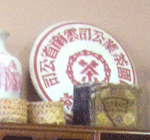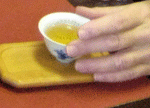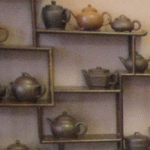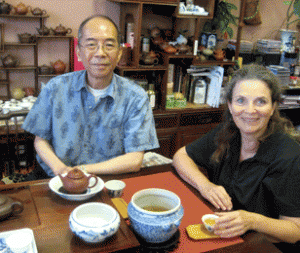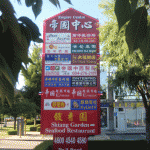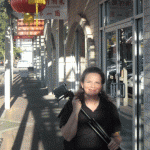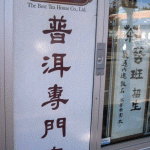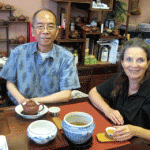Why Is My Green Tea Bitter
Why is my green tea bitter, I wondered. It seemed that no matter what, whenever I made green tea, it turned out to taste bitter. And, my, oh my, was my green tea bitter! I felt really discouraged, since I grew up in Canada, where my family and our neighbors drank tea everyday. However, we drank black tea with milk and sugar. Surely, green tea wouldn’t be that much different to make than black tea, would it?
Well, it took a Chinese tea master to show me how to make my green tea taste fantastic. And, it is different from making black tea. Until he showed me how, I didn’t know the answer to my question: Why is my green tea bitter? But, now I know how to brew green tea the right way, and I love how it tastes. I also don’t need to add sugar to make it palatable. The solution is really simple and easy. Take a look at the video below, where I’ll show you the secret to making delicious green tea and give you the answer to the question: Why is my green tea bitter.
Continue readingChestnuts roasting on an open fire on American Thanksgiving Day!
Happy Thanksgiving Day!
I specify, “American Thanksgiving,” because I grew up in Canada where Thanksgiving was celebrated last month, in October. I guess it’s because the harvest occurs a month earlier in Canada’s colder climate.
Today, it being American Thanksgiving, almost every household is eating exactly the same thing. For a typical American Thanksgiving Day menu, scroll down to the (*).
Chestnuts eaten during the Holidays
However, today, in our house, we are also roasting chestnuts. Yes, I know chestnuts are supposed to be part of the traditional North American Holiday feast, as the popular Yuletide songs says. Nonetheless, Italian chestnuts are now available in the grocery stores, and I simply can’t wait until the end of December to indulge in them.
Happy Hanukkah!
And, speaking of the Holidays, it’s Hanukkah! Evidently, Hanukkah coincides with U.S. Thanksgiving only every 60 years, so, in a way, we are celebrating the Holidays.
Although my home-oven-roasted chestnuts will not measure up to the roasted chestnuts of my youth, I know I will especially enjoy them, because they bring back fond memories of my years on Toronto Island. I wrote about how Toronto Island residents had peacefully and determinedly kept their homes, so beautifully interspersed with nature, from being bulldozed, as an example of how all of us can preserve the natural world in the “Message from Pan,” chapter of my book When We Were Gods.
Chestnuts bring back memories of Toronto Island days
Chestnuts evoke memories of Toronto Island, because, during the time I lived on Toronto Island, during this time of year, the fragrance of roasting chestnuts would greet me as I entered the ferry docks to board the ferries that would take me home to the Island.
Street vendors, swathed in scarves, hats and padded jackets against the cold Canadian weather, would man their steaming carts and shout out to us to buy a bag of their roasted chestnuts. How could I resist? These cart-roasted chestnuts had an exquisite flavor, especially on a brisk or even bitterly blustery cold day while sitting in the outside waiting area for the ferry, not to mention how they warmed up my frozen fingers.
Chestnuts are an Alkaline Food
Chestnuts are one of the few nuts – almonds being the other ones – which are an alkaline-reacting food. They’re also rich in protein.
How to Roast Chestnuts
Here’s a link to a video on how to roast Italian chestnuts. There’s also a transcript if you prefer to read instead of watch a video.
*Typical American Thanksgiving Menu:
- Roast turkey
- Turkey stuffing
- Turkey gravy
- Cranberry sauce
- Mashed potatoes
- Mashed turnips or rutabagas mashed with carrots
- Candied yams or sweet potato casserole made with marshmallows and brown sugar
- Green bean casserole with a delicious crunchy onion topping
- Pumpkin pies topped with whipping cream
Continue reading
Health tip: Drink pu-erh Chinese tea to lower cholesterol and triglycerides
Another thing I’ve learned from visiting Chinese tea houses is that pu-erh tea, which sounds a lot like “poor” but is pronounced more like poo-er with the accent on the first syllable, is supposed to be a very healthy drink. When I visited The Best Tea House in Richmond, British Columbia, the proprietor Michael Fung’s assistant tried to get me to pronounce it correctly in Chinese, but I finally gave up after exhausting my tongue.
The Best Tea House specializes in pu-erh tea. This is a tea that is considered medicinal in China, although it is made from the leaves of the same tea plant (Camellia sinensis) that produces green (unfermented), oolong (partially fermented), and black (fully fermented) teas. Pu-erh is not only fermented but also aged for a long time, usually years.
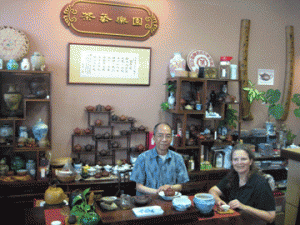
Michael Fung’s The Best Tea House in Richmond, BC. Note the wrapped Pu-erh tea cakes on the upper right and left shelves.
To my senses, pu-erh tea cake or brick, before it’s steeped, smells like hay in a stable – a pleasant earthy aroma – but just a bit strange when you consider that you’re going to break a piece off, infuse it with hot water, steep it, and then drink the resulting tea. However, after it’s steeped – and the Gong Fu style of tea drinking is often used for savoring pu-erh – it smells, to me, more like black tea. I like that it has less caffeine that green, oolong or black tea.
According to an article on “Pu-erh” in WebMD, not only does pu-erh contain less caffeine, which stimulates the central nervous system, heart, and muscles (Eek, maybe I should lighten up on the green tea), but also pu-erh contains antioxidants and “other substances that might protect the heart and blood vessels.”
Michael Fung suggested puerh tea for me, because it is “warm” rather than “cold” like green tea, and will therefore be less likely to create agitation in the body, as I understood him. I assume the “warm” and “cold” refer to properties in Chinese medicine.
OK, so here’s the really exciting part: I was surprised to read in the WebMD article that studies have shown that drinking pu-erh tea can reduce cholesterol. The article surmises that this can be due to pu-erh containing small amounts of a chemical called lovastatin, which is prescribed to lower cholesterol. Other research indicates that drinking pu-erh tea may lower triglycerides as well as low-density lipoprotein LDL (“bad” cholesterol) and raise high-density lipoprotein HDL (“good” cholesterol).
Interestingly, a Financial Times article about California cooking expert Alice Waters says that Alice has attributed a personal cholesterol drop of 100 points to puerh tea!
Wow! I’m getting encouraged to get over my issues with pu-erh’s hay/stable aroma.
According to the WebMD article on puerh tea, it is produced mainly in the southwestern part of China in the Yunnan district. Michael Fung told me that this area also has many tall old tea trees – ancient tea trees, some of them hundreds or even thousands of years old.
Tea trees? I thought tea leaves grew on bushes. Well, it turns out that the tea plant will become a tree and that there are wild old tea trees in Yunnan, China. For a photo of an old tea tree, take a look at Andrew Stein’s Wild China blog post, The Ancient Tea Trees of Southern Yunnan.
Photographs by John J. Chapman, used with permission.
Continue readingChinese Tea Gong Fu Style using Yixing teapots
One of the many things I especially like about Chinese tea in a genuine Chinese teashop, is the use of tiny Yixing (pronounced Yee-shing) teapots, which are part of the traditional Gong Fu style tea service.
Gong fu style tea involves three or four infusions of tea in one tiny Yixing teapot using the same leaves. Before you start the infusions, you first fill the clay teapot and your teacups with hot water to heat up the chinaware. Then you pour off that water from the teapot, add about a heaping teaspoon of leaf tea, fill the teapot with hot, but not boiling, water and pour that water off. Since tea leaves are dried in the air, they can contain dust, and this first rinse pours off the dust and impurities. Finally, you start the infusions, the first one lasting about 30 seconds. Each infusion lasts longer, and even though the tea is steeped longer, because you’re using the same tea leaves, the last infusion is the weakest. My favorite infusion is usually the second.
Here I am enjoying Chinese tea with Michael Fung at The Best Tea House in Richmond, British Columbia. It’s one of a group of shops headquartered in Hong Kong.
Photographs by John J. Chapman, used with permission.
Continue readingHealth tip: Drink Chinese Green Tea
I love to visit Richmond, British Columbia, because it’s almost like going to China. Almost 50 percent of the population is from Asia. At times, with all the Chinese lettering on the shops, you almost think you are in China, especially in the Empire Center mall. If it wasn’t for the English letters on the sign, I might forget I was in Canada!
It’s such a wonderful place for taking video footage. On this day, I was looking for The Best Tea House, a tea shop I had found online, because of my fascination with drinking Chinese green tea and the lovely little teaware accessories found in Chinese tea shops.
 My fascination with green tea came as a result of doing the 40-day Manifestation Prayer, described in my latest book, Have Your Heart’s Desire. This is a wonderful prayer I learned from J. Everett Irion and is based on the spirituality messages in the Edgar Cayce readings. You have to pray the prayer every day for 40 days before anything happens. On the 41st day of my prayer for wealth, I ended up in front of a Chinese tea shop. This felt strange since I’d been praying for wealth, but, my doctor had recently told me to drink green tea as a preventative. When I went in the shop, I discovered that I’d been drinking packaged green tea incorrectly and was told the right way to drink green tea. Basically, the prayer had brought me to health, rather than wealth. Then, I realized that health is probably the greatest wealth on earth.
My fascination with green tea came as a result of doing the 40-day Manifestation Prayer, described in my latest book, Have Your Heart’s Desire. This is a wonderful prayer I learned from J. Everett Irion and is based on the spirituality messages in the Edgar Cayce readings. You have to pray the prayer every day for 40 days before anything happens. On the 41st day of my prayer for wealth, I ended up in front of a Chinese tea shop. This felt strange since I’d been praying for wealth, but, my doctor had recently told me to drink green tea as a preventative. When I went in the shop, I discovered that I’d been drinking packaged green tea incorrectly and was told the right way to drink green tea. Basically, the prayer had brought me to health, rather than wealth. Then, I realized that health is probably the greatest wealth on earth.
So, on this day, I was happy to have found The Best Tea House in the Empire Center and went in to have some tea with the proprietor, Mr. Michael Fung.
(Photographs in Richmond, BC, by John J. Chapman, used with permission.)
Continue readingSprucing things up on my site
I’ve been busy going over my website, updating the look, and making a few improvements. I also realized that there are some features missing from my previous books. For example, I haven’t posted any excerpts. I’m going to be correcting those overlooked items in the coming days so keep an eye out for those posts.
Continue readingMemories of the poem, The Shell
Yesterday, I felt really happy to receive a comment from Marsha about a post I made on April 3, 2011, about a hauntingly lovely poet, The Shell. Marsha also remembered it from learning it in high school.
It begins with:
AND then I pressed the shell
Close to my ear
And listened well,
And straightway like a bell
Came low and clear
The slow, sad murmur of the distant seas,
Whipped by an icy breeze
Upon a shore
Wind-swept and desolate.
It’s by by James Stephens. Do you remember this poem? It has stayed with me over the years.
I thought it would be easy to find a photo among all of my 100s, maybe 1000s, of photos to illustrate this post, but it seems I’ve always taken pictures of the beach either in sunlight or with footprints in the sand, so my beach pictures look cheery and with evidence of humanity. Do you have a photo that evokes the desolate mood of The Shell?
Continue readingPrayer is an Energy Path
I just received the suggestion on my Facebook page, to present prayer as an energy path. I like that.
My Facebook page is at www.Facebook.com/CarolChapman8
Continue readingIs there a country in which you’re more likely to have HIV/AIDS than in the U.S.?
Yesterday, I looked at a comparison between the U.S. and Canada, Mexico, and Germany on this delightful website: If It Were My Home. I discovered that if you lived in all of the above countries, you would be much less likely to have HIV/AIDS than if you lived in the U.S.
Therefore, I asked myself: Is there any country where you’d be MORE likely to have HIV/AIDS than the U.S.? Sudan, which is the country just south of Egypt, came to mind. I’ve read (is it an urban legend?) that so many people in the Sudanese army are sick with HIV, that they often can hardly march. Maybe that’s an exaggeration. However, AIDS did start in Africa.
Here are the results of a comparison between the U.S. and Sudan:
- Die 25.72 years sooner
- Have 2 times more chance of being unemployed
- Have 12.7 times higher chance of dying in infancy
- Spend 98.93% less on health care
- Be 2.3 times more likely to have HIV/AIDS
So, there you have it, a country in which you would be more likely to have HIV/AIDS than if you lived in the U.S. Do I feel comforted? Not really.
Continue reading
In which country would you live the longest: the U.S., Canada, Mexico, or Germany?
If you lived in Canada instead of the U.S., you would:
- Live 3.05 years longer
- Spend 45.33% less on health care
- Have 18.73% less chance of dying in infancy
- Have 8.6% chance more of being unemployed
- Be 33.33% less like to have HIV/AIDS
What about a comparison with the United States’ southern neighbor, Mexico? You would:
- Die 1.98 years sooner
- Spend 88.42% less on health care
- Have 2.9 times greater chance of dying in infancy
- Have 39.8% more chance of being unemployed
- Be 50% less likely to have HIV/AIDS
What about Germany?
- Live 1.17 years longer
- Spend 48.43% less money on health care
- Have 35.67% less chance of dying in infancy
- Have 11.83% more chance of being unemployed
- Be 83.33% less likely to have HIV/AIDS
Interested in a comparison with France? Luxembourg? Australia? Check out this nifty website: If It Were My Home. You can also compare countries other than the U.S. with other countries on the website.
Continue reading